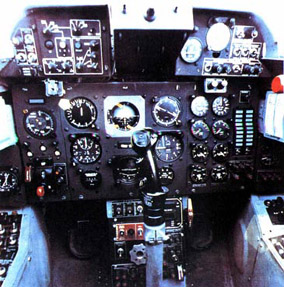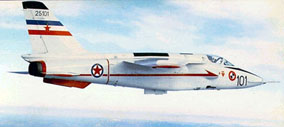Manufacturer:
Vazduhoplovna Industrija
SOKO DD and Centrul Nacional al Industriei Aeronautice Romane (later Iav Craiova and now
Avioane)
Country of
origin:
Yugoslavia and Romania
Class:
Attack warplane
Type:
Close air support, ground
attack and tactical reconnaissance warplane with limited air-defense capability
Powerplant:J-22B
Orao 2: Two Orao/Turbomecanica (Rolls-Royce/Bristol Siddeley) Viper Mk 633-41 turbojets
each rated at 17.79 kN dry and 22.24 kN with afterburning
Fuel capacity: Internal
fuel 2430 kg; external fuel up to 1500 kg in tree 500 liter drop tanks; no provision for
in-flight refueling
Dimensions:
Wing: Span 9.30 m; aspect
ratio 3.33; area 26.00 m2
Fuselage and tail
dimensions: Length 14.90 m including probe; height 4.52 m; tailplane span 4.59 m; wheel
track 2,50 m; wheel base 5.40 m
Operational weights: Empty
5500 kg equipped; normal take-off 8170 kg; maximum take-off 11080 kg
Performance:
Maximum speed: Maximum level speed ‘clean’ 1020 km/h at 11000 m and 1130 km/h or Mach
1.06 at sea level; cruising speed, maximum 743 km/h at 11000 m
Maximum range: Ferry range
1320 km with two drop tanks; radius 522 km on a hi-lo-hi attack mission with four cluster
bombs and one drop tank, or 460 km on a hi-lo-hi attack mission with four 500 kg air mines
and one drop tank, or 370 km on a hi-lo-hi attack mission with eight 250 kg bombs and one
drop tank
Maximum rate of climb at
sea level 5340 m per minute; climb to 6000 m in 1 minute 20 seconds; service ceiling 15000
m
G limits: -4.2 to +8
Supersonic: Yes
Crew:
Pilot on a Martin-Baker Mk Y10LB zero/zero ejector seat |

Fixed armaments:
Two 23-mm Gryazev-Shipunov GSh-23L two-barrel cannon with 200 rounds per gun in the
undersides of the inlets
Disposable armaments: Up to 2800 kg of disposable stores on five hardpoints
(one under fuselage rated at 800 kg, and four under the wings each unit rated at 500 kg);
typical loads are five 500, 250 or 100 kg free-fall or retarded bombs, or four triplets of
100 or 50 kg free-fall or retarded bombs, or eight 250 kg free-fall or retarded
fragmentation bombs, or five or eight BL755 cluster bombs, or clusters of smaller
fragmentation or incendiary bombs, or four 360 kg FLAB-350 napalm tanks, or four or eight
L-57-16MD or L-128-04 multiple launchers each carrying 55 mm or four 128 mm unguided
rockets respectively, or two AGM-65 Maverick or Grom ASMs
|

Electronics
& operational equipment: |
Standard communication and
navigation equipment, plus (fire control and weapons management) Thompson-CSF VE-120T HUD
replacing the original Ferranti ISIS D-282 gyro sight (defensive sensors and systems) Iskra
SO-1 RWR and provision for up to tree chaff/flare dispensers and P10-65-13 passive jammer pod,
and (navigation) Honeywell SGP500 twin-gyro platform; there is also provision for an
optical/IR reconnaissance pod or a optical reconnaissance/jammer pod
|
Operators:
Romania (201), SFR Yugoslavia (215). |
Total manufactured by
variant: |
J-22 - SFR Yugoslavia (165) |
IJ-22 - SFR Yugoslavia (15) |
NJ-22 - SFR Yugoslavia (35) |
IAR-93A - Romania
(36) |
IAR-93B - Romania (165) |
|
|
|
Variants: |
IAR-93A: A simple
yet effective light attack and tactical reconnaissance warplane well suited to the
operational requirements and capabilities of the two sponsor nations, this type was
designed from 1970 as a shoulder-wing monoplane of all-metal construction with swept
flying surfaces and tricycle landing gear. The type is known to the Yugoslavs as the SOKO
J-22A Orao 1 and to the Romanians as the CNIAR (later Iav Craiova and now Avioane)
IAR-93A. Each country built two prototypes (one single-seater and one two-seater), the
single-seaters making their first flight on the same day in October 30, 1974 and two-seat
prototypes following in January 1977. Next came 30 pre-production aircraft (15 each in
Romania and Yugoslavia) that flew during 1978 and through a successful development program
paved the way for the type to enter full production in Romania during 1979 and in
Yugoslavia during 1980. The first model to enter in service, in 1981, was the IAR-93A
produced in single-seat form purely for the operational role and in two-seat form for the
conversion and armament training roles. Both variants have provision for a maximum
disposable load of 1500 kg on five hardpoints (one under the fuselage rated at 500 kg and
four under the wings with the inner two units each rated at 500 kg and the outer two units
each at 300 kg). In other respects, the IAR-93A differs from J-22B Orao 2 in details such
as the accommodation of its one or two crew members on one or two Martin-Baker Mk RU10J
zero/zero ejector seats, a non-afterburning powerplant of two Turbomecanica/Orao
(Rolls-Royce/Bristol Siddeley) Viper Mk 632-41R turbojets each rated at 17.79 kN dry and
supplied with fuel from an internal capacity of 2950 liters in single-seat model or 2700
liters in the two-seat model, length of 14.90 m including probe for the single-seat model
or 15.38 m including probe for the two-seat model, wheel base of 5.40 m for the
single-seat model or 5.88 m for the two-seat model, empty equipped, normal take-off and
maximum take-off weights of 6150, 8826 and 10326 kg respectively, maximum level speed
‘clean’ of 1070 km/h at sea level, maximum cruising speed of 730 km/h at 7000 m, ferry
range of 1900 km with tree drop tanks, radius of 260 km on a lo-lo-lo attack mission with
four rocket launchers, or 380 km on a hi-hi-hi patrol with tree drop tanks, or 450 km on a
lo-lo-hi attack mission with two rocket launchers, six 100 kg bombs and one drop tank, or
530 km on a hi-hi-hi attack mission with four 250 kg bombs and one drop tank, maximum rate
of climb at sea level of 2040 m per minute, and service ceiling of 10500 m. Production of
this Romanian version was completed by the delivery of 26 single-seaters and 10
two-seaters.
 |
|
IAR-93B: This is
the upgraded Romanian version first flown in 1985 and produced in single-seat and
two-seats forms to a total of 165 aircraft. The variant has integral fuel tankage rather
than rubber fuel cells in the wings for a maximum fuel capacity of 3120 liters, can carry
a maximum disposable load of 2800 kg on uprated hardpoints, and is fitted with an
afterburning powerplant of two Viper Mk 633-41 turbojets each rated at 17.79 kN dry and
22.24 kN with afterburning. In other respects, the IAR-93B differs from the J-22B Orao 2
in details such as its empty equipped, normal take-off and maximum take-off weights of
5700, 8400 and 11200 kg respectively, maximum level speed ‘clean’ of 1160 km/h at sea
level, maximum cruising speed of 1089 km/h at 5000 m, maximum rate of climb at sea level
of 4500 m per minute, and service ceiling of 13200 m. Some IAR-93s are configured for the
low-level air defense role with a twin-rail unit on each underwing hardpoint for a total
of eight AAMs.
|
IJ-22 Orao 1: This
designation is applied to the 15 Yugoslav-built pre-production aircraft (including a few
completed to INJ-22A Orao two seat standard) with the non-afterburning powerplant and used
for the tactical reconnaissance role with a centerline pod carrying optical and/or IR
sensors. In other respects, the IJ-22A Orao 1 differs from the J-22B Orao 2 in details
such as its powerplant of two Viper Mk 632-41R turbojets each rated at 17.79 kN dry and
supplied with fuel from an internal weight of 2360 kg, length of 14.90 m including probe
for single seat model or 15.38 m including probe for two-seat model, wheel base of 5.40 m
for single-seat model or 5.88 m for two-seat model, empty equipped weight of 5755 kg,
normal take-off weight of 8500 kg with reconnaissance pod, maximum take-off weight of
9500, maximum level speed ‘clean’ of 1033 km/h at 8000 m and 1050 km/h at sea level,
maximum rate of climb at sea level of 2280 m per minute, climb to 6000 m in 3 minutes 12
seconds, and service ceiling of 13500 m.
|
J-22A Orao 1: This
is the Yugoslav variant equivalent to the IAR-93A with a non-afterburning powerplant of
two Orao/Turbomecanica (Rolls-Royce/Bristol Siddeley) Viper Mk 632-41R turbojets each
rated at 17.79 kN dry, but the larger and more diverse weapons load of the J-22B carried
on that variant’s higher- rated hardpoints. The variant first flew in October 1983 and
was built only in single-seat form.
|
J-22B Orao 2: This
is the Yugoslav variant equivalent to the IAR-93B with an afterburning powerplant,
integral wing tankage, the greater weapons load and diversity of the J-22A Orao 1, and
Thomson-CSF HUD. The variant is being built only in single-seat form, and J-22A/B
production will total 165 aircraft. Yugoslavia planned a major upgrade of its J-22 Oraos
with a radar and a computer nav/attack system integrated via a MIL 1553B digital database,
but the dissolution of Yugoslavia and the civil war of the early 1990s made this an
unlikely happenstance. NJ-22 Orao: This is the dedicated two- seat reconnaissance variant
operated by the Yugoslav Air Force with provision for a reconnaissance pod (with optical
and IR sensors) carried on the centerline hardpoint. The type first flew in July 1986, and
35 were delivered in NJ-22A Orao 1 and NJ-22B Orao 2 forms with non-afterburning and
afterburning powerplants respectively. |
|